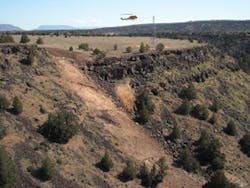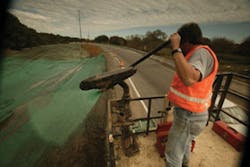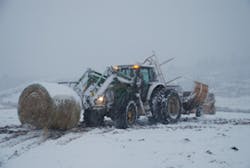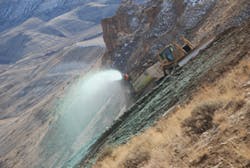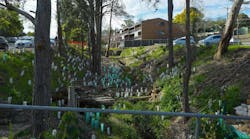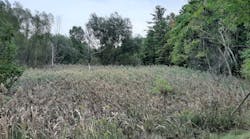There are slopes and then there are slopes.
Some of the slopes on the back sides of the dams around Horsetooth Reservoir in Colorado, for example, reached 1:1 and stretched as much as 800 to 1,000 feet long. The hydroseeding equipment used on the reclamation project was pulled up and supported on its way down by tractors on narrow roads constructed especially for the job.
On the other hand, the Ruby Natural Gas Pipeline reclamation project involved working on terrains that ranged from wetlands to steep mountains, in multiple states, with multiple contractors, private landowners, and federal agencies.
The Garden State Parkway Expansion in New Jersey posed logistical problems such as setting up the staging area in a different but always confined location every day and meeting a strict deadline in spite of being shut down when it rained and when traffic was too heavy.
Other challenges hydroseeding companies face are tree trunks and boulders, erratic winds, and lack of access, all of which make it difficult to spray seed and mulch evenly.
Whatever the challenges and the limitations, though, there’s a mulch, a seed mix, and an application technique to overcome them, as the following projects show.
Horsetooth Reservoir
Horsetooth Reservoir stretches 6.5 miles through a narrow valley in the foothills just 5 miles west of Fort Collins, CO. While it supplies water for drinking, irrigation, hydropower generation, and recreation, for years it also posed hidden dangers. According to the US Bureau of Reclamation (USBR), seepage was increasing under one of its 50-year-old earthfill dams, and all four of its dams were susceptible to earthquake damage. Tens of thousands of people live downstream.
Spraying Hyper-Straw Guar Plus on a flatter section of the Garden State Parkway
The Modernization of the Dam project, which took more than two and a half years, was completed in 2003. Horsetooth Dam, to the north, was repaired; the downstream faces of the three dams to the east, Soldier Canyon, Dixon Canyon, and Spring Canyon dams, were stabilized; and all four dams were made earthquake safe.
In 2004, Rocky Mountain Reclamation (RMR), in Laramie, WY, stepped in to reclaim the backsides of the three dams to the east. During the modernization project, equipment had pushed soil from the tops of the dams down the backsides, where it had either settled in an angle of repose or been graded to different slope gradients, says Ron Schreibeis, president and co-owner with his wife, Valerie, of RMR. The company provides consulting services relating to revegetation and reclamation and is also a reclamation construction contractor.
“This was a fairly complex project with quite a variety of revegetation techniques,” Schreibeis says.
Because soil settles at different angles, depending on the type of soil, and because grading requirements varied depending on site design criteria, these slopes ranged from 1:1 to 3:1 or flatter, and they were very prone to erosion. RMR used a number of seed varieties, mulches, and application techniques to protect them, including seed, virgin aspen wood fiber mulch, and Biosol, an organic soil amendment, from Granite Seed in Lehi, UT.
Horsetooth Reservoir is part of the Colorado-Big Thompson project, which is designed to collect water from the headwaters of the Colorado River and divert it from Colorado’s West Slope to its Front Range and plains. It’s owned by USBR and has an elevation of 5,430 feet and a total capacity of about 151,750 acre-feet.
The long, narrow reservoir runs north-south and is bounded by mountains on the south and the west, Horsetooth Dam on the north, and the Dakota Hogback, a long ridge at the edge of the Rocky Mountains, on the east. Soldier, Dixon, and Spring canyons cut through the hogback. They were dammed up in the mid- to late-1940s when the reservoir was built. They’re between 155 and 240 feet high and contain more than 10 million cubic yards of earthfill. The project reclaimed just under 100 acres.
The first challenge was the logistics. “At three different points, three streams had broken through along the hogback and formed three valleys,” Schreibeis says. “We worked in three locations with three different access points, three sources of water, and three areas to store our materials.”
While the flatter slopes had been graded with dozers, a major challenge was getting the 65,000-pound hydroseeding machines up and down the steepest slopes, many of them 800 to 1,000 feet long.
Because the slopes were so steep and long, the contractor had built roads to get the equipment up, and because the roads had to be built fairly
Straw mulching in Scare Canyon, UT
level from side to side, they were narrow. RMR hooked the machines to tractors with a tow cable to pull them up and to control their speed on the way down-dangerous work. “We went through all the procedures with the safety department,” he says.
The company used seed, mulch, and techniques that were specified by USBR engineers.
“Normally we make recommendations for modifications,” Schreibeis says.
“Specs are often boilerplated because engineers often don’t have the time or resources to research a project like this. But most of the recommendations and procedures were already done.”
Workers applied several different mixes of cool- and warm-season native dryland grasses, depending on the slope. All were from Granite Seed, which carries a wide variety of seed and erosion control products.
“We work with Granite Seed often,” he says. “Generally, for most of our situations, they are the best. Few other companies can compete with their quality and service. They generally have a good inventory even of the more specialized species we require.”
Some of the seed was specifically for wildlife habitat. “We want wildlife to utilize and graze revegetated areas. If they don’t, and if livestock don’t have access, there’s often a long-term decrease in the quality and condition of the vegetation. For most rangeland in the West, controlled grazing is a good thing for the land.”
On the flatter land, crews generally drill-seeded tame pasture seed mixtures, and then mulched with certified noxious-weed-free grass hay mulch. They crimped in the mulch with specially designed, RMR-constructed mulch crimpers.
On the steeper slopes they primarily applied 100% virgin aspen wood fiber mulch from Granite Seed. According to Granite Seed, the thermally refined wood fibers have up to 50% more water-holding capacity than atmospherically refined wood mulch, which allows them to absorb water rapidly.
Applying the mulch evenly around the boulders, some of which reached the size of small pickups, was another challenge. “The contractors had built the minimum possible number of roads, so our operators didn’t have good access,” Schreibeis says. “Once they were on the slopes, the main challenge was for them to make sure the mulch covered the seed.”
Crews used the winds, working in one area and then when the winds changed, going to another spot. They tried to cover the seed as quickly as possible with at least three coats of hydromulch to protect it from rodents and birds, sun, and wind and water erosional forces, but during this project the wind could change before they finished. They would either try to get at least a couple of loads on before it changed, or wait until it changed back.
On the steepest, most difficult slopes the crews applied a bonded fiber matrix mulch and Biosol. According to Granite Seed, Biosol was developed in the same way as slow-release vitamins; it won’t burn seed or existing vegetation and it doesn’t require watering immediately after application.
“Biosol provides macronutrients, organics, and other desirable components for enhancing revegetation establishment,” Schreibeis says.
When the hydromulching was finished, the roads up the slopes had to be obliterated, and going down was sometimes more frightening than going up.
“Because the roads were narrow, an excavator would get up the road ahead of us and wipe out 30 to 40 yards of road at a time,” Schreibeis says. “Then he’d ease himself off the road, and we’d back up and spray it out, then pull down the road out of his way and hold ourselves on the slope while he’d pull back on the road and wipe out another 30 to 40 yards. It took good operators to do that, and there were a number of potential hazards and dangerous situations that we addressed before and during this procedure to assure safe working conditions for our people.”
It was a very slow, tedious process, he says, “but it was one of those costly things that there was no way around. According to the contractor and what we’ve learned from the city, the project went wonderfully and is a success.”
Ruby Natural Gas Pipeline
The Ruby Natural Gas Pipeline snakes through four states, from the southwest corner of Wyoming to southern Oregon, through terrain that ranges from wetlands to desert to some of the steepest mountains in the country, and through farmland and public land regulated by multiple federal agencies including the Bureau of Land Management, the Forest Service, and the Federal Energy Regulatory Commission.
Arnold’s Custom Seeding (ACS), in Keenesburg, CO, reclaimed 558 of the nearly 680 miles of the pipeline, through the heat of the summer and the snow, ice, and darkness of the winter. The company, which specializes in reclamation, forest restoration, and erosion control, used a wide variety of seeding and mulching techniques.
“It depended on what each district wanted and the angle of the slope,” says Corey Huwa, who runs the family-owned company with his brother, Brent. One product the company used is the relatively new WoodStraw, an erosion control mulch by Forest Concepts in Auburn, WA. It’s a blend of loose, long, thin wood pieces, almost like writing pencils, Huwa says, that was applied from the ground and the air. They also used straw mulch, Terra-Matrix SMM (Stabilized Mulch Matrix), Flexterra HP-FGM (High Performance Flexible Growth Medium), and DustFloc.
Ecology and Environment Inc. (E and E) of Lancaster, NY, did the environmental studies before El Paso Corp.’s 42-inch underground pipeline, which delivers natural gas to California, Nevada, and the Pacific Northwest, was built. A number of companies carried out the construction.
“When they do the pipeline, they clear the vegetation and push the topsoil to one side of the right of way,” Huwa says. Crews place the fill on the opposite side. Once the pipeline is in, the contractors replace everything, including rocks, as closely as possible to where they found them.
ACS started work in October 2010 and finished mulching in September 2011. Another company is transplanting seedlings.
Brent Huwa, along with employees Matt Dorenkamp and James Simpson, managed the eastern side of the approximately 8,500-acre project. Corey Huwa, with employees Shawn Hesse and Brice Larrick, handled the western two-thirds. The temporary easements along the 558 miles varied from the nominal width of 115 feet to as wide as 195 feet on steep slopes and as narrow as 75 feet near wetlands, archeological sites, and other areas of significance.
On BLM land, much of which is leased to ranchers for pasture, ACS replaced everything as closely as possible to the locations E and E had found them. “BLM districts like the right of way to be in a roughened state,” Huwa says. “It can help catch some water, protect delicate sprouts from the wind, and create a mini-geological climatic growing habitat.”
On land that wasn’t rocky, ACS tilled to relieve the soil compaction. E and E had identified the soils, and had found that on much of the land they were good and fertile. ACS treated poor soils with its proprietary blend of soil amendments. On cryptobiotic soils, where organisms had stopped growing because of the adverse environmental conditions, ACS added mycorrhizal inoculum (AM 120) from Granite Seed in Lehi, UT.
ACS seeded with seed mixes that E and E had prescribed. On federal land, they planted almost all native seed. On BLM land that was leased to ranchers for pasture they planted grass. On private land they planted according to landowner requests. “Most of the seed came from Sharp Brothers in Greeley,” Huwa says. “We use them a lot.”
Crews drill-seeded most of the job. If the conditions were unsafe for the equipment, they broadcast seeded and harrowed, and if the conditions were unsafe for broadcasting from the ground, they broadcast by air. They also used broadcast seeding for species that must be placed on the surface in order to germinate, such as sagebrush, forage kochia, and yarrow.
The mulch and the application depended on the degree of the slope and the landowners and agencies in charge. Most of the time, Huwa made recommendations that were approved on a case-by-case basis. The BLM districts in Nevada, however, specified WoodStraw by Forest Concepts, because they wanted to ensure that the mulch wouldn’t contain any weeds.
According to Forest Concepts, each piece in the mulch has a high length-to-width ratio, so the pieces, mostly Douglas fir, hemlock, and other conifer species, form a protective matrix when they’re distributed on the soil. WoodStraw can be spread by hand, straw blower, or helicopter, is naturally weed free, provides shade for seeds, and doesn’t get displaced by wind, even on steep slopes. It does not need to be crimped into the soil.
WoodStraw Lasts Four Years or More
ACS applied several truckloads both from the ground and by air. “We have seen some light reeling under the product,” Huwa says, “but this method can be less expensive than hydromulch or erosion control blanket for slopes where water erosion is not a concern.”
The Wyoming section was fairly flat, he says, which allowed the company to apply certified weed-free straw with mechanical straw blowers on the ground. Crews crimped the straw 3 or 4 inches into the soil to hold it into the ground.
The Utah section, on the other hand, is very extreme, he says. “There are areas with super-steep slopes and highly erosive soils. A lot of that had to be done by helicopter.”
On the flatter areas, crews applied straw from the ground and crimped it in. On the moderate slopes, they applied Terra-Matrix SMM from Profile Products, also from the ground. It’s basically a mixture of wood mulch and glue that goes on as a slurry and binds with the soil, Huwa says.
On the steepest slopes with highly erodible soil, they applied Flexterra HP-FGM, also from Profile Products, from both the ground and the air. “It’s basically a virgin wood mulch and a cross-linked tackifier,” he says. “It’s more expensive up front, but it will protect an extreme slope until vegetative growth is established.”
In Oregon the company aerially applied DustFloc, a soil binder made of a blend of natural and organic polysaccharides, from Apex Resources of Louisville, KY. It’s an inexpensive way to protect the soil from water and wind erosion, but doesn’t provide shade for seeds.
So far, the soils have held very well, Huwa says, but he does expect that some areas will have to be retreated within the next two or three years. Rainfall mostly will help, since this is a very dry part of the world.
“We’ve had unbelievable vegetation success across Oregon and Nevada due to careful product selection, good seed, specialized installation and application methods, and an unusual amount of precipitation during the winter months. We’ve had great success across Utah and Wyoming as well.Our goal is for the right-of-way scar to disappear within five to seven years,” he says.
“It’s nice to work with a gas company like El Paso that genuinely cares about doing the job right the first time and doesn’t ask us to take any shortcuts. This attitude ensures protection of wildlife, water, and all of our natural resources.”
Garden State Parkway Expansion
Sometimes the slopes are the easy part.
ACS applied Flexterra HP-FGM on the steepest
slopes with the most highly erodible soils.
The Garden State Parkway used to be known for traffic congestion to and from the beaches and the casinos on the New Jersey shore. Thanks to a road-widening project by the New Jersey Turnpike Authority, traffic is running more smoothly now. The project expanded a 13-mile stretch of the two-lane divided highway by adding a new slow lane in each direction as well as widening the shoulders.
Once the expansion was completed, Hydrograss Technologies, which specializes in engineered solutions in erosion and dust control as well as stormwater management, took over.
“The tracked equipment used for large tree removal during the road-widening process had disturbed and exposed soils, leaving them ripe for erosion,” says Bob Arello, president of the company, which has offices in Massachusetts and Florida. Hydrograss stabilized the median, the easements, and the on and off ramps. The company used seed from Summit Seed in Manteno, IL. On flat surfaces, crews applied the hydromulch HydroStraw Guar Plus, also from Summit Seed, and GeoMatrix SS, a soil-specific BFM from its own company, for the slopes.
The main challenges during this project had little to do with slopes. Instead, they concerned logistics as well as limited time and space.
By the time work began in March 2011, some of the challenges had already been solved. One was synchronizing the 18 shipments of HydroStraw that came in by truck from Oregon.
“The holding yard was only so big,” Arello says. “Ron [Edwards, of HydroStraw] helped a lot with organizing the freight liners and the people involved in shipping. We’d get around three to four trucks a week-22 tons of material a load.”
And then there was the logistics of hauling the water needed for the hydroseeding and hydromulching. The job site was a couple of miles from the ocean, and the other sources of water were anywhere from 14 to 26 miles away. Hydrograss used four 6,000-gallon water trucks to transport water from the ocean into two 21,000-gallon frac tanks that were positioned daily at strategic points to expedite the seeding operation.
Crews set up staging areas in highway turnarounds. It was faster, and they had to be as efficient as possible because dictated labor rates were well over $70 per hour for each man. Going back to the holding area would have been too costly, Arello says. Because they were constantly progressing up the road, every morning they moved all the equipment and products to a new holding area for the work they were doing that day.
The highway was never closed while the crews worked. Instead, the Turnpike Authority would close a section about 2 miles long of either a northbound or southbound lane, and either the fast lane, so they could spray the easements, or the slow lane, so they could spray the median. When Hydrograss finished spraying, the Turnpike Authority would move up another 2 miles and close that section, and the crew would repeat the process, Arello says.
“If there was too much traffic, they shut us down.” At the same time, he says, “it was mandatory that the work be accomplished before Memorial Day, or liquidated damages would have been assessed to the general contractor.”
Hydrograss Technologies applied the seed and fertilizer first. One of Summit Seed’s specialties is turf grass seed mixtures for low-maintenance turf. This was a rye and fescue blend that was approved by the Turnpike Authority. It was intended to last only a couple of years, because additional bids for more construction and widening projects were in the pipeline to take place the following season.
Workers covered the easements, which were between 60 to 150 feet wide to the wood line, the shoulders, the median, and the on and off ramps. Although the easements were flat, applying the seed and the mulch evenly was tricky, too.
“The contractors had cut the trees as tight to the ground as possible as per specifications,” Arello says. “They tried to get 1 to 2 inches from the soil, but the ground was very undulating.”
The Turnpike Authority had specified blown hay as a cover material, but it was impossible to reach the 150 feet from the guard rails to the tree line with conventional hay-blowing machines, and there was no vehicle access to most of the seeded areas. In addition, a constant driving wind could have created severe dust and blown the hay onto the highway instead of the target area, says Arello, who also does onsite evaluations.
“We suggested to the contractor that we replace the blown straw with HydroStraw Guar Plus, because the wet delivery system both prevents dust and helps in the ease of application. We had the equipment to get the job done. We drove two trucks down from the Northeast and one truck up from Florida.”
HydroStraw Guar Plus was applied on the 390 acres of flatter land-the easements, the shoulders and the medians. According to HydroStraw, the manufacturing process results in greater soil coverage and higher water retention. The product was preblended to eliminate field mixing, with processed straw fibers, a guar gum tackifier, and a high-strength polymer binder to ensure smooth operation. It binds to the soil to prevent erosion, protects seed, and helps it germinate. Hydrograss used 1,900 pounds per acre and covered 2 acres per load.
On the 44 acres of on and off ramps, which were 3:1 slopes or greater, Hydrograss used its own GeoMatrix SS, which stabilizes severe slopes, as the Turnpike Authority had specified. The company used one Finn T-330, one Apex Extreme 4200, and one Apex Extreme 5,000-gallon hydroseeding machine to complete the contract.
The project was finished right after Memorial Day. “Some days we covered 30 acres with the trucks,” Arello says. “It was tough, but with an experienced crew and some of the best equipment in the industry, we accomplished the work.”